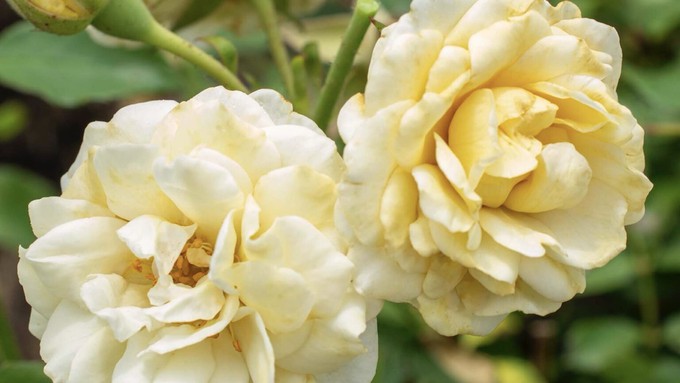
Participate in national Roses in Review survey

This is Buttercream Drift, a groundcover rose that stays under 2 feet tall Photo courtesy Star Roses
Love it or hate it? When it comes to evaluating new varieties, gardeners always have opinions.
Here’s an opportunity to make those opinions count!
It’s the annual Roses in Review survey, conducted by the American Rose Society. Gardeners from coast to coast are asked to rate newly introduced rose varieties. The scores are then compiled and averaged into a national rose rating, published in the ARS’s annual “Handbook for Selecting Roses.”
“This will be the 99th time Roses in Review will be conducted in which rose growers everywhere can review new roses they’ve grown in their own garden,” says the ARS. “Roses included in the survey have generally been on the market one to four years and are available commercially, although some on a limited basis.”
Diversity of reporters is important, notes national coordinator Don Swanson. “We need your evaluations, whether you grow one of the varieties on the survey list or dozens of them. We welcome evaluations from you whether you are a new rose grower, a ‘garden’ rose-grower or a seasoned veteran grower; whether you grow roses for your landscape and garden or if you also grow them to exhibit or arrange.”
ARS membership is not necessary; anyone who grows roses is invited to take part.
New rose varieties are scored on a scale of 6 to 10 for such attributes as color, fragrance and disease resistance. (Why not 1 to 10? If a rose earns less than a 6 or “C” grade, it’s not worth growing.)
The survey includes two ratings: Garden and Exhibition. “Garden” rates how that rose looks and performs in a garden on the bush. (Is it always in bloom? Does it look nice with little effort?) “Exhibition” rates how that rose performs as a cut flower in a rose show. (Are the stems long? Does the cut flower hold its form without falling apart?)
Rose lovers are notoriously hard scorers; even the very best rose varieties very rarely earn a 10.
Here’s a scoring breakdown from Swanson:
10: Outstanding – One of the best roses ever. This score should be seldom used.
9: Excellent – Has major positive features and minor negatives – top 1 percent.
8: Very Good Rose – You would recommend it without hesitation.
7: Average – Solid rose. Good features easily outweigh the negatives.
6: Below Average – You can find better roses easily.
(That also offers insight into the published ratings.)
Not all roses are rated every year – there are too many! (Thousands of roses have ratings.) Instead, the roses on the review list are mostly new varieties or ones that had not yet been rated but are becoming known to a wider audience. Most roses on this year’s list first hit nurseries in 2020 or later. There also are five varieties that for whatever reason had not been previously rated or needed revisions.
Among the roses on this year’s review list are several low-growing “groundcover” or landscape roses such as Buttercream Drift as well as more traditional hybrid teas and floribundas.
Deadline is coming soon – 5 p.m. PDT Sept. 26. The survey is conducted online at www.rose.org. Roll down to find the link to the list of 200-plus candidates, under the “List of cultivars.”
The survey uses a series of drop-down menus. One question will be to name your "district" (that's your rose-growing region). Use "NCNH" -- Northern California, Nevada, Hawaii. Otherwise, it's pretty simple and fast.
Future rose growers will thank you!
Comments
0 comments have been posted.Sacramento Digs Gardening to your inbox.
Food in My Back Yard Series
May 6: Maintain soil moisture with mulch for garden success
April 29: What's (already) wrong with my tomato plants?
April 22: Should you stock up on fertilizer? (Yes!)
April 15: Grow culinary herbs in containers
April 8: When to plant summer vegetables
April 1: Don't be fooled by these garden myths
March 25: Fertilizer tips: How to 'feed' your vegetables for healthy growth
March 18: Time to give vegetable seedlings some more space
March 11: Ways to win the fight against weeds
March 4: Potatoes from the garden
Feb. 25: Plant a fruit tree now -- for later
Feb. 18: How to squeeze more food into less space
Feb. 11: When to plant? Consider staggering your transplants
Feb. 4: Starting in seed starting
Sites We Like
Garden Checklist for week of May 4
Enjoy this spring weather – and get gardening!
* Plant, plant, plant! It’s prime planting season in the Sacramento area. Time to set out those tomato transplants along with peppers and eggplants. Pinch off any flowers on new transplants to make them concentrate on establishing roots instead of setting premature fruit.
* Direct-seed melons, cucumbers, summer squash, corn, radishes, pumpkins and annual herbs such as basil.
* Harvest cabbage, lettuce, peas and green onions.
* In the flower garden, direct-seed sunflowers, cosmos, salvia, zinnias, marigolds, celosia and asters. (You also can transplant seedlings for many of the same flowers.)
* Plant dahlia tubers. Other perennials to set out include verbena, coreopsis, coneflower and astilbe.
* Transplant petunias, marigolds and perennial flowers such as astilbe, columbine, coneflowers, coreopsis, dahlias, rudbeckia and verbena.
* Keep an eye out for slugs, snails, earwigs and aphids that want to dine on tender new growth.
* Feed summer bloomers with a balanced fertilizer.
* For continued bloom, cut off spent flowers on roses as well as other flowering plants.
* Add mulch to the garden to maintain moisture. Mulch also cuts down on weeds. But don’t let it mound around the stems or trunks of trees or shrubs. Leave about a 6-inch to 1-foot circle to avoid crown rot or other problems.